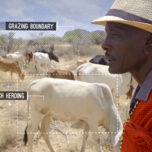July 1, 2019 — Freshly cut grass is a quintessential smell of summer. While the smell might conjure memories of lemonade stands and kids playing outside, it also serves another purpose. Plants — not just grass — with leaves damaged by lawn mowers or, more often, plant-eaters out for lunch, release smells that subtly manipulate the behavior of plants and insects around them.
The subtle odors plants emit are made up of small molecules called volatile organic compounds (VOCs). Neighboring plants can detect some of those VOCs and recognize them as a warning signal that insects or other herbivores are nearby. In response, those plants can produce molecules that make them toxic or unappealing to the herbivore. Moreover, the predators of those herbivores can, in some cases, detect VOCs released by plants. To them, the VOCs are like the dinner bell.
Not only that, but VOCs also can inhibit the growth of bacterial and fungal pathogens, stymie weed growth, and help plants cope with stressful conditions like drought.
Now, researchers are exploring ways to harness VOCs to trim the need for pesticides in some farming systems while protecting the harvest and bolstering plant production in stressful environments. And they’re learning from the smallholder farmers who, year after year, already take advantage of VOCs.
In sub-Saharan Africa, for example, they note that more than 120,000 smallholder farmsteads use VOCs to improve crop performance. In southwestern Kenya, some growers plant maize varieties that, upon detection of egg-laying stemborers, emit VOCs that attract stemborer parasitoids. While these maize varieties have lower yield than common commercial varieties, this intrinsic protection from pests make them attractive to many growers, particularly those who cannot afford commercial seeds and pesticides.
In another application, sub-Saharan African farmers grow their crops alongside companion plant species with VOCs that either repel plant-eating insects or attract their predators. Some companion plant species can also capture nitrogen, control weeds, help crops tolerate drought, or provide food for livestock.
So “Why are VOCs not more intensively used in agriculture for integrated and eco-friendly plant protection?” the researchers ask.
Convincing growers to switch to lower-yielding varieties to cut back on pesticide use is a tough sell. And although laboratory studies show promise, in many cases the approach has not been thoroughly tested in the field. We don’t know how each VOC affects other organisms or ecosystems; for example, one VOC that suppresses the growth of a stone-fruit fungus is also toxic to some stone fruits. According to these researchers, further work is needed to understand how VOCs interact with the plants, insects and microbes of an ecosystem before the technique can successfully expand to different farming locations and systems.
Such research and expansion might take advantage of breeding or genetic technologies to reintroduce VOC production into high-yielding commercial crop varieties. Alternatively, research could focus on identifying or breeding ideal companion plants that bring the specific benefits needed to a given agro-system. The companion crops best suited to the pests and climactic challenges in sub-Saharan Africa might not be best for other growers around the world. Another option is to expose seedlings to manufactured synthetic VOCs in greenhouses, tricking the seedlings into making insect-deterring molecules before being planted outside.
To encourage integration of VOCs into current farming systems, researchers, growers, breeders and agricultural advisers might build mutually beneficial collaborations with growers who already use VOCs in their agricultural systems. VOCs may not be the solution to plant pest problems, but if the smallholder farmers using them and the researchers studying them are correct, they certainly could be a solution worth pursuing.
Related Posts
Ensia shares solutions-focused stories free of charge through our online magazine and partner media. That means audiences around the world have ready access to stories that can — and do — help them shape a better future. If you value our work, please show your support today.
Yes, I'll support Ensia!



